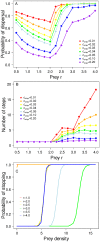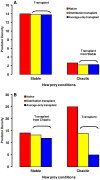Evolution of predator dispersal in relation to spatio-temporal prey dynamics: how not to get stuck in the wrong place!
- PMID: 23408940
- PMCID: PMC3569443
- DOI: 10.1371/journal.pone.0054453
Evolution of predator dispersal in relation to spatio-temporal prey dynamics: how not to get stuck in the wrong place!
Abstract
The eco-evolutionary dynamics of dispersal are recognised as key in determining the responses of populations to environmental changes. Here, by developing a novel modelling approach, we show that predators are likely to have evolved to emigrate more often and become more selective over their destination patch when their prey species exhibit spatio-temporally complex dynamics. We additionally demonstrate that the cost of dispersal can vary substantially across space and time. Perhaps as a consequence of current environmental change, many key prey species are currently exhibiting major shifts in their spatio-temporal dynamics. By exploring similar shifts in silico, we predict that predator populations will be most vulnerable when prey dynamics shift from stable to complex. The more sophisticated dispersal rules, and greater variance therein, that evolve under complex dynamics will enable persistence across a broader range of prey dynamics than the rules which evolve under relatively stable prey conditions.
Conflict of interest statement
Figures






Similar articles
-
Maladapted Prey Subsidize Predators and Facilitate Range Expansion.Am Nat. 2019 Oct;194(4):590-612. doi: 10.1086/704780. Epub 2019 Aug 21. Am Nat. 2019. PMID: 31490731
-
Intense or spatially heterogeneous predation can select against prey dispersal.PLoS One. 2012;7(1):e28924. doi: 10.1371/journal.pone.0028924. Epub 2012 Jan 11. PLoS One. 2012. PMID: 22247764 Free PMC article.
-
Ecological and evolutionary consequences of predator-prey role reversal: Allee effect and catastrophic predator extinction.J Theor Biol. 2021 Feb 7;510:110542. doi: 10.1016/j.jtbi.2020.110542. Epub 2020 Nov 23. J Theor Biol. 2021. PMID: 33242490
-
Eco-Evolutionary Dynamics: The Predator-Prey Adaptive Play and the Ecological Theater.Yale J Biol Med. 2018 Dec 21;91(4):481-489. eCollection 2018 Dec. Yale J Biol Med. 2018. PMID: 30588213 Free PMC article. Review.
-
Predicting Predator Recognition in a Changing World.Trends Ecol Evol. 2018 Feb;33(2):106-115. doi: 10.1016/j.tree.2017.10.009. Epub 2017 Nov 10. Trends Ecol Evol. 2018. PMID: 29132776 Review.
Cited by
-
Inter-annual variability influences the eco-evolutionary dynamics of range-shifting.PeerJ. 2014 Jan 2;2:e228. doi: 10.7717/peerj.228. eCollection 2014. PeerJ. 2014. PMID: 24498572 Free PMC article.
-
The concerted emergence of well-known spatial and temporal ecological patterns in an evolutionary food web model in space.Sci Rep. 2021 Feb 25;11(1):4632. doi: 10.1038/s41598-021-84077-0. Sci Rep. 2021. PMID: 33633237 Free PMC article.
-
Genetics of dispersal.Biol Rev Camb Philos Soc. 2018 Feb;93(1):574-599. doi: 10.1111/brv.12356. Epub 2017 Aug 3. Biol Rev Camb Philos Soc. 2018. PMID: 28776950 Free PMC article. Review.
-
An empiricist's guide to theoretical predictions on the evolution of dispersal.Interface Focus. 2013 Dec 6;3(6):20130028. doi: 10.1098/rsfs.2013.0028. Interface Focus. 2013. PMID: 24516715 Free PMC article. Review.
References
-
- Bowler DE, Benton TG (2005) Causes and consequences of animal dispersal strategies: relating individual behaviour to spatial dynamics. Biol. Rev. Cambridge Phil. Soc. 80: 205–225. - PubMed
-
- Simmons AD, Thomas CD (2004) Changes in dispersal during species’ range expansions. Am. Nat. 164: 378–395. - PubMed
-
- Phillips BL, Brown GP, Webb JK, Shine R (2006) Invasion and the evolution of speed in toads. Nature 439: 803. - PubMed
-
- Lachmuth S, Durka W, Schurr FM (2011) Differentiation of reproductive and competitive ability in the invaded range of Senecio inaequidens: the role of genetic Allee effects, adaptive and nonadaptive evolution. New Phyt 192: 529–541 doi:10.1111/j.1469–8137.2011.03808.x. - DOI - PubMed
-
- Kokko H, Lopez-Sepulcre A (2006) From Individual Dispersal to Species Ranges: Perspectives for a Changing World. Science 313: 789–791 doi:10.1126/science.1128566. - DOI - PubMed
Publication types
MeSH terms
LinkOut - more resources
Full Text Sources
Other Literature Sources

